Abstract
Two new species of the Polynema group of genera (Chalcidoidea: Mymaridae), Palaeoneura razii Anwar, Zeya and Usman sp. nov. and Acmopolynema misbahae Anwar, Zeya and Usman sp. nov. are described from India. Palaeoneura razii is quite remarkable in having short axillar setae and the posterior margin of the fore wing without a distinct lobe and curve. Hence, together with another described species, P. farmani Amer and Zeya from India, this new taxon is placed in the informal farmani species group of the genus Palaeoneura. In addition, we record new country and state records for two other species, A. dilemma Triapitsyn and Berezovskiy and A. malabaricum Subba Rao, respectively. A key to the Indian genera of the Polynema group is also provided.
Article LSID: http://urn:lsid:zoobank.org:pub:D844F28F-6883-4B17-B433-23D3231CE719 Species LSID: Palaeoneura razii Anwar, Zeya & Usman http://urn:lsid:zoobank.org:act:864A3309-9A66-4722-8F1C-40F32E0AAB82 Acmopolynema misbahae Anwar, Zeya & Usman http://urn:lsid:zoobank.org:act:E4721150-0824-4085-BEAD-376D7EBDE03
Introduction
The Polynema group in India includes the following seven genera: Acmopolynema Ogloblin, Himopolynema Taguchi, Mymar Curtis, Narayanella Subba Rao, Polynema Haliday, Palaeoneura Waterhouse and Stephanodes Enock (Noyes Citation2022). It is one of the most diverse groups of Mymaridae (Hymenoptera: Chalcidoidea), with many species still to be described. In India, the included genera are distinguished from genera outside the Polynema group by: female funicle 6-segmented (, , ); clava 1-segmented (entire) (, , ); fore wing venation with punctiform marginal/stigma vein, and entire venation less than one-fourth the length of the fore wing (, , ); and gastral petioles distinctly longer than wide (, ). Hayat and Anis (Citation1999a, Citation1999b) were the first to review species of Polynema Haliday and Acmopolynema Ogloblin from India. Subba Rao and Hayat (Citation1983) provided a preliminary catalogue and key to Oriental Mymaridae. The most recent papers on some Indian genera of the Polynema group were provided by Rehmat and Anis (Citation2016) on Polynema, Amer et al. (Citation2017) on Mymar Curtis, Amer and Zeya (Citation2019) on Palaeoneura Waterhouse and Manickavasagam et al. (Citation2017) on Acmopolynema. Triapitsyn and Berezovskiy (Citation2007) reviewed and keyed Oriental and Australasian species of the Polynema group.
Figures 1–4. Palaeoneura farmani Amer and Zeya, holotype, ♀: (1) head, frontal; (2) antenna; (3) wings; (4) part of fore wing enlarged.
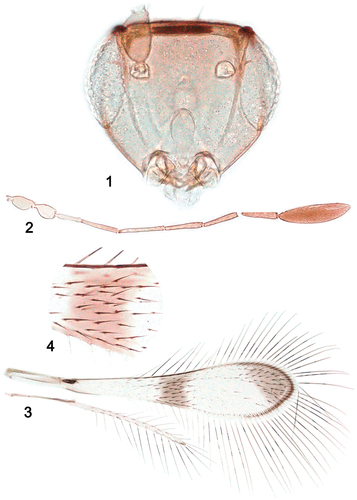
Figures 5–7. Palaeoneura farmani Amer and Zeya, paratype, ♂: (5) head, frontal; (6) antenna; (7) wings.
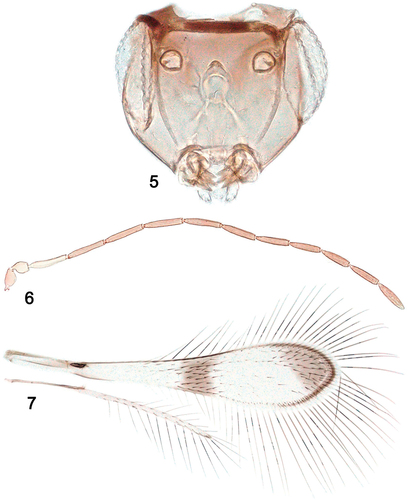
Figures 8, 9. Palaeoneura farmani Amer and Zeya: (8) mesosoma and gaster with petiole, holotype, ♀; (9) mesosoma and gaster with petiole, paratype, ♂.
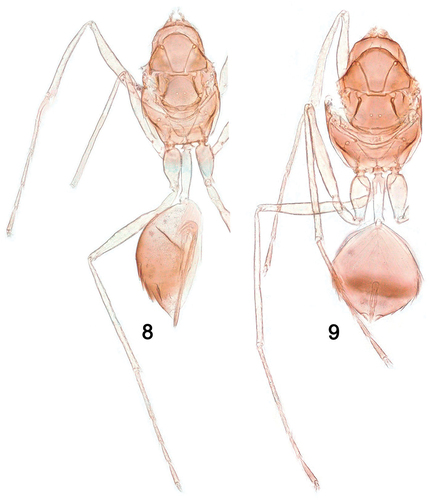
Figures 10–12. Palaeoneura razii Anwar, Zeya and Usman sp. nov., holotype, ♀: (10) habitus; (11) head, frontal; (12) antenna.
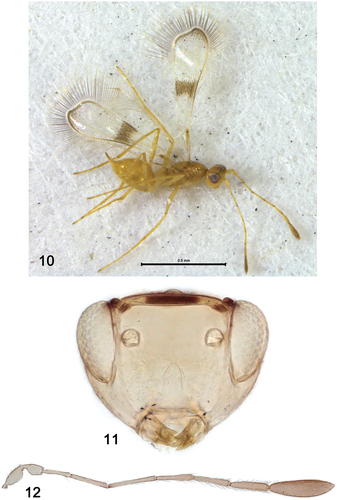
Figures 13–17. Palaeoneura razii Anwar, Zeya and Usman sp. nov., holotype, ♀: (13) wings; (14) part of fore wing enlarged; (15) mesosoma with petiole; (16) gaster; (17) legs.
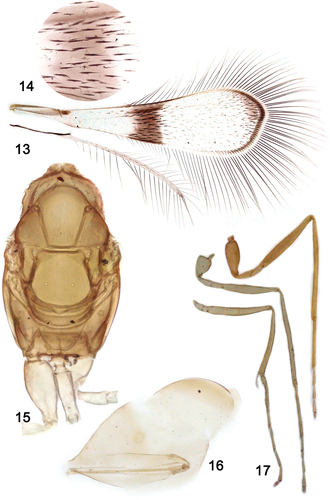
Figures 18–21. Acmopolynema misbahae Anwar, Zeya and Usman sp. nov., holotype, ♀: (18) habitus; (19) antenna; (20) fore wing; (21) part of fore wing enlarged.
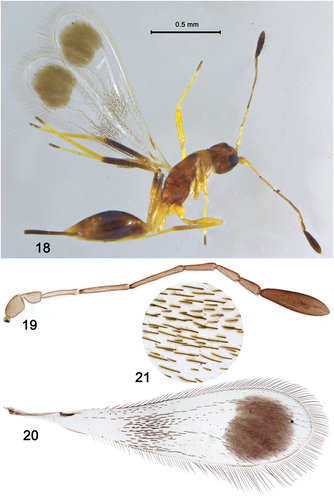
Here, a remarkable farmani species group of Palaeoneura and two new species of the Polynema group – Palaeoneura razii Anwar, Zeya and Usman sp. nov. and Acmopolynema misbahae Anwar, Zeya and Usman sp. nov. – are described from India. We also provide a key to Indian genera of the Polynema group and further record some known species from India.
Material and methods
Well-preserved slide-mounted specimens are a pre-requisite to study these tiny parasitic wasps. Slides were prepared following Anwar et al. (Citation2020). For morphological terms Zeya and Hayat (Citation1995) and Gibson (Citation1997) were followed. Measurements of body lengths were taken from card-mounted specimens; all other measurements were taken from slide mounts and were later converted to μm. Length of antennal scape excludes the radicle. Specimens were photographed using a stereozoom binocular Nikon SMZ 1000, and photographs of slide-mounted parts were taken with a digital camera attached to a Nikon Eclipse DM 2500 compound microscope and retouched using Adobe Photoshop®. All identified materials, including type specimens, were deposited at the Insect Collections Department of Zoology, Aligarh Muslim University, Aligarh, Uttar Pradesh, India.
The following abbreviations are used:
| F | = | = funicle segment |
| mps | = | =multiporous plate sensillum or sensilla |
| MT | = | = Malaise trap |
| SN | = | = sweep net |
| YPT | = | = yellow pan trap |
The following abbreviations are used for specimen depositories:
| BMNH | = | –Natural History Museum [formerly British Museum (Natural History)], Department of Entomology, London, UK. |
| ZDAMU | = | –Insect Collections Department of Zoology, Aligarh Muslim University, Aligarh, Uttar Pradesh, India. |
Results
(modified from Triapitsyn & Berezovskiy Citation2007)
1. Fore wing oar-like in shape, with a long narrow petiole and partly patched blade; hind wing without membrane, either filamentous or abbreviated; scape at least 6.3× as long as broad and constricted mediallyMymar Curtis
-. Fore wing shape not oar-like; hind wing with a membrane; scape at most 4× as long as broad and not constricted medially2
2(1). Apical funicle segment as wide as clava, clava only slightly differentiated from it; metatibia with setae at least twice as long as tibia width; metacoxa longer than petioleNarayanella Subba Rao
-. Apical funicle segment distinctly narrower than clava, clava clearly differentiated from it (, , ); metatibia with setae about as long as width of tibia (); metacoxa subequal to petiole3
3(2). Fore wings with slight to distinct narrowing beyond apex of venation, slightly sinuate; axillar seta usually long, sometimes extending to anterior margin of propodeumPalaeoneura Waterhouse
-. Fore wings with posterior margin not narrowing beyond apex of venation; axillar seta short, at most one-third scutellum length4
4(3). Scape medially with imbricate (rasp-like) sculpture; face with subantennal grooveStephanodes Enock
-. Scape either smooth or with cross ridges (, , ) but without imbricate sculpture; face without subantennal groove extending ventrally from each torulus (, )5
5(4). Propodeum with a straight complete or incomplete median carina6
-. Propodeum with either “V”, “Y” or sub-parallel median carinae7
6(5). Propleura not abutting anteriorlyPolynema (Polynema Haliday)
-. Propleura abutting anteriorly (sometimes only barely so)Polynema (Doriclytus Foerster)
7(5). Face with a pit adjacent to each torulus; fore wing hyaline, with setae neither thickened nor otherwise modified; axillar seta often strong and blunt; propodeum with Y-shaped median carinae or with subparallel median carinae, often separating from each other in the middleHimopolynema Taguchi
-. Face without a pit adjacent to each torulus; fore wing with brown patch in most species, with setae often thickened basally or sometimes otherwise modified (, ); axilla with setae weak and pointed; propodeum with V-shaped median carinaeAcmopolynema Ogloblin
Key to Indian genera of the Polynema group
Taxonomy
1. Axillar setae short; posterior margin of fore wing without a distinct lobe and curve () (Palaeoneura farmani species group) 2
-. Axillar setae usually long; posterior margin of fore wing with a distinct lobe and curveall other Palaeoneura species
2. Fore wing narrow, 5.2× as long as broad (); marginal seta sparse, 1.7× as long as maximum wing widthPalaeoneura farmani Amer and Zeya
-. Fore wing broad, 3.6× as long as broad (); marginal setae dense, 1.3× maximum wing width ……… Palaeoneura razii Anwar, Zeya and Usman sp. nov.
Key to species of the Palaeoneura farmani species group
Palaeoneura farmani species group
()
Diagnosis
Female
Members of the Palaeoneura farmani species group differ from those of other species/species groups of Palaeoneura by the following unique combination of features: axillar setae short; fore wing () with posterior margin without a distinct lobe and curve and, apex slightly angular, not rounded; metatibia with setae not longer than width of tibia; propodeum without a distinct carina.
Male
Similar to female, except for secondary sexual features.
Description
Female. Body length 700–987 µm. Colour. Body including antenna and legs yellowish brown. Wings subhyaline except medially and apex with dark brown patch.
Head (, ). Head in frontal view distinctly wider than long; face smooth; torulus at mid eye level, separated by more than its own width from transverse trabecula. Pedicel shorter than all funicular segments individually. Mesosoma (, ). Pronotum entire, clearly visible in dorsal view, with several stout and blunt setae. Propleura abutting each other, thus covering the prosternum anteriorly. Mesoscutum longer than scutellum. Axillar seta short and blunt, extending less than one-third length of scutellum. Propodeum without submedian carinae. Wings (, ). Fore wings with hypochaeta not extending to posterior margin; disc in proximal third with a few setae, more setose in apical two-thirds and those on brown patches modified, spine-like; marginal setae longer than maximum wing width. Metasoma (, ). Ovipositor slightly exserted beyond apex of gaster.
Male
Body size and colour similar to female.
Palaeoneura farmani Amer and Zeya
()
Palaeoneura farmani Amer and Zeya, Citation2019: 202, female, male. Holotype, female, India, Kerala (ZDAMU), examined.
Type material examined
Holotype ♀ (ZDAMU, registration No. Hym. Ch.800, on slide, under four coverslips, slide No. MYM.1420) INDIA: KERALA: Ernakulam, Kozhancherry, 12.i.2012 (SN), Coll. F. R. Khan. Paratype ♂ (ZDAMU, registration No. HYM.CH.800, on slide, under four coverslips (slide No. MYM.1434) INDIA: KERALA: Pathanamithetta, Ommathur, 14.i.2012, Coll. F. R. Khan.
Distribution
India: Kerala.
Host
Unknown.
Palaeoneura razii Anwar, Zeya and Usman sp. nov.
()
Type material
Holotype ♀ (ZDAMU), (on slide under five coverslips, slide No. MYM.615): INDIA: TAMIL NADU: Dindigul, Shembaganur, 2.iv.2011 (MT), Coll. K. Veenakumari.
Diagnosis
Palaeoneura razii Anwar, Zeya and Usman sp. nov. has distinctively broader fore wing with dense marginal setae than any of the Palaeoneura species. It most closely resembles P. farmani Amer and Zeya, the only other described species in the group, but differs from it as follows: clava 3.8× as long as broad, shorter than F5 and F6 combined (clava 4.6× as long as broad, longer than F5 and F6 combined in farmani); fore wing 3.6× as long as broad; marginal setae dense, 1.3× maximum wing width (fore wing 5.2× as long as broad; marginal seta sparse, 1.7× as long as maximum wing width in farmani); petiole 3.6× as long as broad; ovipositor 1.2× mesotibia length and subequal to metatibia length (petiole 5.11× as long as broad; ovipositor 0.9× mesotibia, 0. 9× metatibia length in farmani).
Description
Female
Length, 987 µm. Body including antennae and legs yellowish brown. Wings subhyaline except medially and apex with dark brown patch.
Head (). Head, in frontal view 1.5× as broad as high, with numerous stout, blunt setae. Antenna () with scape 2× as long as broad; pedicel smaller than all funicular segments individually, 1.7× as long as broad; funicles all long and cylindrical, F1 the shortest and F3 the longest; clava 3.8× as long as broad, shorter than F5 and F6 combined, with five mps.
Mesosoma (). Pronotum entire with numerous stout, blunt setae. Mesoscutum smooth, 1.6× as broad as long, subequal to scutellum length. Scutellum and propodeum smooth. Fore wing () apically angular, 3.6× as long as broad; longest marginal seta 1.2× as long as maximum wing width; disc with distinct brown patch in middle and at apex, with about 17 microtrichia in basal half whereas apical half uniformly setose; brown area of wing with modified, spine-like microtrichia. Hind wing () 40× as long as broad; longest marginal seta 9× as long as maximum wing width. All coxae smooth ().
Metasoma (). Petiole 3.6× as long as broad; ovipositor 1.2× mesotibia and subequal to metatibia length.
Measurements (µm): head width:height, 250:163; antennal segments length:width–scape, 13:13; pedicel, 70:33; F1, 75:13; F2, 108:15; F3, 130:15; F4, 100:18; F5, 100:18; F6, 108:20; clava, 180:48; mesosoma, 363; pronotum, 15; mesoscutum, 125; scutellum, 113; metanotum, 45; propodeum, 50; fore wing length:width, 1175:325; longest marginal seta, 375; hind wing length:width, 900:23; longest marginal seta, 200; protibia, 275; mesotibia, 375; metatibia, 425; petiole length:width, 125:35; gaster, 575; ovipositor, 438.
Male
Unknown.
Host
Unknown.
Distribution
India: Tamil Nadu.
Etymology
The species is named after Dr Syed Mohammad Razi (MBBS, MD, DM-endocrinology) for his excellent contributions in the field of medical sciences.
Comments
Amer and Zeya (Citation2019) provided a key and brief review of the Indian species of the kusnezovi species group of Palaeoneura and described P. farmani Amer and Zeya. Our newly described species P. razii sp. nov. does not share affinities with the kusnezovi species group but does share features with P. farmani. Indeed both species have short axillar setae, and an unlobed and almost straight posterior margin of the fore wing. Therefore, we describe here a new farmani species group and place both species within it.
Genus Acmopolynema Ogloblin, Citation1946
Acmopolynema misbahae Anwar, Zeya and Usman sp. nov.
()
Type material
Holotype ♀ (ZDAMU, on slide under four coverslips, slide No. MYM.614): INDIA: SIKKIM: Tadong, ICAR Comp., 29.x.2014 (YPT), Coll. K. Veenakumari.
Diagnosis
Acmopolynema misbahae Anwar, Zeya and Usman sp. nov. is characterised by antenna with F3 the longest; clava 3.8× as long as broad, smaller than F5 and F6 combined, with eight mps; fore wing disc with one brown patch at apex; blade medially setose with modified blunt setae, apical half with three rows of setae; ovipositor distinctly longer than gaster, 1.7× as long as mesotibia and 1.4× as long as metatibia, exserted part of ovipositor 0.5× gaster. It is most similar to A. malabaricum Subba Rao (Citation1989) in having a circular brown patch on apex of fore wing. However, it differs from the latter by the following features: antenna with F3 longest (antenna with F2 longest in malabaricum); fore wing setose medially and without any infumation (fore wing blade sparsely setose medially with a patch of infumation in malabaricum); and ovipositor exserted about one-third of its total length (ovipositor exserted about one-fifth of its total length in malabaricum).
Affinities
Triapitsyn and Berezovskiy (Citation2007) reviewed and keyed the Oriental and Australasian Acmopolynema. This new species keys to Acmopolynema malabaricum Subba Rao from India, as both taxa have only one conspicuous brown spot at the apex of the fore wing blade. A modified couplet 16 for the key of Triapitsyn and Berezovskiy (Citation2007: 9) is provided here to fit this new species into the key to Oriental and Australasian species of Acmopolynema, females.
16(15) Fore wing blade with one conspicuous brown spot at the apex (, , ) 17’
Figures 22, 23. Acmopolynema Ogloblin, habitus, ♀: (22) A. dilemma Triapitsyn and Berezovskiy; (23) A. malabaricum Subba Rao.

- Fore wing blade with three conspicuous brownish spots and/or bands ()18
17’(16) Fore wing blade medially setose, without infumation (); antenna with F3 longest ()A. misbahae Anwar, Zeya and Usman sp. nov.
- Fore wing blade medially with sparse setation, with a narrow infumation (); antenna with F2 longest ()A. malabaricum Subba Rao
Description
Female
Length, 2029 µm. Body generally reddish brown. Antenna with scape, pedicel, F1 and F2 yellow; funicles F3–F6 yellowish brown; clava brown. Wings subhyaline except a dark brown patch at apex. Fore and middle legs yellow except tarsi-4 brown; hind leg with trochanter, coxa, femur in basal half and tibia in basal one-third yellowish brown; femur in apical half and tibia in apical two-third brown; metatarsi tarsi-1–3 yellow, tarsi-4 brown.
Head (). Head, in frontal view 1.5× as broad as high, with numerous stout, blunt setae. Scape 2× as long as broad; pedicel smaller than all funicular segments individually, 1.7× as long as broad; funicles all long and cylindrical, F1 shortest and F3 the longest; clava long, 3.8× as long as broad, smaller than F5 and F6 combined, with eight mps ().
Mesosoma (). Mesosoma smooth. Pronotum entire, less than half the length of mesoscutum. Fore wing 3.8× as long as broad; longest marginal seta 0.4× as long as maximum wing width (); disc with one brown patch at apex; blade medially setose with modified blunt setae (); apical half with three rows of setae (). Hind wing 50× as long as broad; longest marginal seta 5× as long as maximum wing width. All coxae smooth.
Metasoma (). Petiole 5× as long as broad; ovipositor 1.4× as long as gaster, 1.7× mesotibia and 1.4× metatibia length; exserted part of ovipositor 0.5× gaster.
Measurements (µm): head width:height, 320:288; antennal segments length:width–radicle, 25:25; scape, 100:63; pedicel, 75:45; F1, 145:23; F2, 200:23; F3, 225:25; F4, 125:30; F5, 100:33; F6, 95:38; clava, 285:78; mesosoma, 700; pronotum, 110; mesoscutum, 240; scutellum, 170; metanotum, 50; propodeum, 100; fore wing length:width, 2000:520; longest marginal seta, 210; hind wing length:width, 1500:30; longest marginal seta, 160; protibia, 400; mesotibia, 500; metatibia, 600; petiole length:width, 300:60; gaster, 880; ovipositor, 1240; exserted, 400.
Male
Unknown.
Host
Unknown.
Distribution
India: Tamil Nadu.
Etymology
The species is named after Dr Misbah Shams (MBBS, MD ophthalmology) for her excellent contributions in the field of medical sciences.
New records
Acmopolynema dilemma Triapitsyn and Berezovskiy
()
Acmopolynema dilemma Triapitsyn and Berezovskiy, Citation2007: 33. Holotype female, China, Hainan Island, Tien Fong Mountains (BMNH).
Material examined
2 ♀. INDIA: UTTARAKHAND: Pantnagar, GBPUAT [Govind Ballabh Pant University of Agriculture and Technology], 9.vii.2016 (SN), Coll. O. S. Navik; ANDAMAN AND NICOBAR ISLANDS: South Andaman Forest, Port Blair, CARI [Central Island Agricultural Research Institute], 26.i.2013 (YPT), Coll. K. Veenakumari.
Distribution
India (new record): Andaman and Nicobar Islands, Uttarakhand. China.
Comments
Both specimens from India match well with the original description and illustration of the holotype provided by Triapitsyn and Berezovskiy (Citation2007: 33).
Acmopolynema malabaricum Subba Rao
()
Acmopolynema malabaricum Subba Rao, Citation1989: 153. Holotype female, India, Kerala, Periyar Animal Sanctuary (BMNH).
Material examined
1 ♀. INDIA: MAHARASHTRA: Kolhapur, Panhala, 23.xi.2012 (YPT), Coll. K. Veenakumari.
Distribution
India: Kerala, Maharashtra (new record), Tamil Nadu. China.
Acknowledgements
The authors thank Dr Mohammad Hayat, ZDAMU, for his suggestions and critisism. We are very grateful to Dr K. Veenakumari, NBAIR, Bengaluru, for donating the specimens she collected to the study. Prince T. Anwar gratefully acknowledges the Council of Scientific and Industrial Research (CSIR), New Delhi, India, for providing financial assistance in the form of a Research Associateship. F. R. Khan would like to thank the Deanship of Scientific Research, Qassim University for funding the publication of this study.
Disclosure statement
No potential conflict of interest was reported by the authors.
References
- Amer FSK, Zeya SB. 2019. Review of the Indian species of Palaeoneura Waterhouse (Hymenoptera: Mymaridae). Oriental Insects 53(2):191–211. DOI: 10.1080/00305316.2018.1478754.
- Amer FSK, Zeya SB, Veenakumari K. 2017. A review of the Indian species of Mymar Curtis (Hymenoptera: Mymaridae). Journal of Insect Systematics 3:16–37.
- Anwar PT, Zeya SB, Veenakumari K. 2020. Fairyfly genus Camptoptera Foerster (Hymenoptera: Chalcidoidea: Mymaridae) in India and Sri Lanka, with descriptions of eleven new species. In: Paulus HF, editor. Zoologica. Vol. 165. Stuttgart, Germany: Schweizerbart Science Publishers. pp. 1–89.
- Gibson GAP. 1997. Chapter 2. Morphology and terminology. In: Gibson GAP, Huber JT, Woolley JB, editors. Annotated keys to the genera of Nearctic Chalcidoidea (Hymenoptera). Ottawa: NRC Research Press. pp. 16–44.
- Hayat M, Anis SB. 1999a. The Indian species of Acmopolynema with notes on Acanthomymar (Hymenoptera: Chalcidoidea: Mymaridae). Oriental Insects 33:297–313. DOI: 10.1080/00305316.1999.10433796.
- Hayat M, Anis SB. 1999b. The Indian species of Polynema with notes on Stephanodes reduvioli (Hymenoptera: Mymaridae). Oriental Insects 33:315–331. DOI: 10.1080/00305316.1999.10433797.
- Manickavasagam S, Palanivel S, Triapitsyn SV. 2017. Two new species and additional distributional records of Acmopolynema Ogloblin (Hymenoptera: Mymaridae) from India. Journal of Natural History 51(33–34):1971–1987. DOI: 10.1080/00222933.2017.1356391.
- Noyes JS. 2022. Universal Chalcidoidea database. World Wide Web electronic publication. Available: http://www.nhm.ac.uk/chalcidoids. Accessed Mar 2022 10.
- Ogloblin AA. 1946. Description of new genera and species of Mymaridae (Hymenoptera: Chalcidoidea). Iowa State College Journal of Science 20(3):277–295.
- Rehmat T, Anis SB. 2016. A review of Indian species of Polynema Haliday (Hymenoptera: Mymaridae). Journal of Insect Systematics 2(2):138–166.
- Subba Rao BR. 1989. On a collection of Indian Mymaridae (Chalcidoidea: Hymenoptera). Hexapoda 1:139–186.
- Subba Rao BR, Hayat M. 1983. Key to the genera of Oriental Mymaridae, with a preliminary catalogue (Hymenoptera: Chalcidoidea). In: Gupta VK, editor. Studies on the Hymenoptera. Vol. 20. Gainsville: Contributions of the American Entomological Institute. pp. 125–150.
- Triapitsyn SV, Berezovskiy VV. 2007. Review of the Oriental and Australasian species of Acmopolynema, with taxonomic notes on Palaeoneura and Xenopolynema stat. rev. and description of a new genus (Hymenoptera: Mymaridae). Zootaxa 1455:1–68. DOI: 10.11646/zootaxa.1455.1.1.
- Zeya SB, Hayat M. 1995. A revision of the Indian species of Gonatocerus Nees (Hymenoptera: Chalcidoidea: Mymaridae). Oriental Insects 29:47–160. DOI: 10.1080/00305316.1995.10433741.
